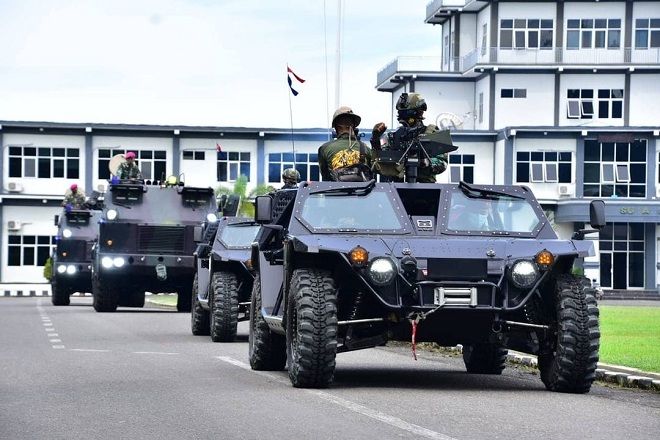
project reality PR Guns - The 2A42 (For those who still looking for the "real" Beast)
By =VG= Inch,
Project Reality: BF2 Guns and Firearms
Q: What is this again?
A: Is about the one and only "Beast" of automatic cannon, the 30mm Shipunov 2A42-!
Q: Is that also available in PR?
A: Hell YES! Basically as main platform turret of BMP-2, BMP-3 and also in gunner seats in Russian-made Attack Choppers, Mil Mi-28 'Havoc'
The 30 mm automatic cannon 2A42, also known as the Shipunov 2A42, is a Soviet/Russian 30 mm automatic cannon. It is built by the Tulamashzavod Joint Stock Company.
- Teh Design:
The 30 mm 2A42 cannon has a dual feed. One is for HE-T and the other for AP-T rounds. The gunner can select one of two rates of full automatic fire, low at 200 to 300 rds/min and high at 550 to 800 rds/min. According to the manufacturer, effective range when engaging ground targets such as light armoured vehicles is 1,500 m while soft-skinned targets can be engaged out to 4,000 m. Air targets can be engaged flying at low altitudes of up to 2,000 m at subsonic speeds and up to a slant range of 2,500 m. In addition to being installed in a two-person turret on the BMP-2 mechanised infantry combat vehicle, this gun is also fitted in the BMD-2 airborne combat vehicle, BMD-3 airborne combat vehicle and BTR-90 (or GAZ-5923) 8×8 armoured personnel carrier. A small number of these have now entered service. More recently, the 30 mm 2A42 cannon has been installed in a new turret and fitted onto the roof of the BTR-T heavy armoured personnel carrier based on a modified T-54/T-55 MBT chassis. The cannon is also the main armament of BMPT (Tank Support Fighting Vehicle). It is also used for various armament projects from various manufacturers. The design bureau for the 30 mm 2A42 cannon is the KBP Instrument Design Bureau. The 2A42 autocannon has also been used on the Bumerang-BM, an unmanned remote control turret on the Kurganets-25 and T-15 Armata.
- Teh Ammunition:
The 2A42 fires 30x165 ammunition, a cartridge introduced in the 1970s in the Soviet Union to replace previous 30 mm autocannon cartridges. Other weapons using this size of cartridge case include the 2A38 and 2A72 autocannons for various vehicle, helicopter and air defence applications, as well as numerous single-, dual- and six-barrel naval and air force cannons. The 2A42, 2A38 and 2A72fire percussion-primed ammunition; the naval and aerial cannons use electrical priming, and therefore their ammunition is not interchangeable with the land-based ammunition types, despite the same cartridge case size.
Originally three basic types of ammunition were developed in the Soviet Union for the land-based weapons: high-explosive incendiary, high-explosive fragmentation with tracer, and an armour-piercing ballistic capped with tracer. Later a sub-caliber armour-piercing round was introduced, and today also countries other than Soviet Union/Russia manufacture 30 x 165 percussion-primed ammunition. The main types of ammunition are:
- 3UOF8 HEI ( High Explosive Incendiary )
- 3UOR6 HE-T ( High Explosive - Tracer )
- 3UBR6 APBC-T ( Armor Piercing Ballistic Capped - Tracer )
- 3UBR8 APDS ( Armor Piercing Discharging Sabot )
- Teh Platforms:
The autocannon has been used since the 1980s on the following platforms:
*Infantry Fighting Vehicles (IFV):
- BM-2T Stalker (Belarusian-made BMP)
- BMP-2 (Mid-Generation of Russian Amphibious IFV, still used along with BMP-3 and widely used by Middle, Eastern Countries)
- BMP-3 (Current generation of Russian Amphibious IFV)
- BMD-2 (Airborne Version of BMP-2)
- BMD-3 (Airborne Version of BMP-3)
- BTR-80A (Improvement of BTR-80 from BPU-1 KPVT 14.5mm HMG to BPPU 30mm 2A72)
- BTR-82A (Improvement of BTR-80A)
- BTR-90 (Russian BTR-80 replacement who's never showed up in-game, in BF2 does)
- BTR-T (Russian T-55 Tank based Heavy IFV)
- BMPT 'Terminator' (Russian T-72 Tank based Armored Fighting Vehicle, being abandoned in favor of Armata Universal Combat Platform project)
- Fahd 280-30 (Egyptian-made IFV based on original Fahd 4x4 APC)
- MT-LB 6MB (So-called 'Beast' title, currently in PR )
- Boragh (Iranian Upgraded version of Chinese Type 86 IFV)
- T-15 Armata (Next-generation of Russian Heavy IFV, part of Armata Universal Combat Platform project)
- Kurganets-25 (Next-generation of Russian Medium APC-IFV, a lighter version of T-15 Armata, this is also part of the project)
- Lazar 3 (Serbian-made AFV/MRAV, from Lazar armored vehicles family)
*Attack Helicopters:
- Mil Mi-28 'Havoc'
- Kamov Ka-50 'Black Shark'
- Kamov Ka-52 'Alligator'
- Kamov Ka-29 'Helix-A'
- Similar 30 mm Autocannons:
The 2A72 30mm autocannon, designed by KBP Instrument Design Bureau, is a lighter, less complex cousin of the 2A42. While the latter has 578 parts, 2A72 has only 349 parts, allowing it to weigh only 84 kg.Its rate of fire is 400 rd/min.
The 2A38 is a 30mm twin-barrel autocannon. It is mainly used on air defense vehicles like 2K22 Tunguska and Pantsir-S1. It weighs 195 kg and has a maximum rate of fire of 2500 rd/min.
- Teh Specifications and Variants:
Type Autocannon Place of origin Soviet Union Service history In service 1980 Used by Russia Production history Designer KBP Designed 1970s Manufacturer Tula Machine-Building Plant Produced 1980 Variants 2А72 Specifications Weight 115 kilograms (254 lb) Length 3.027 m (9 ft 11.2 in) Barrel length 2,416 millimetres (95.1 in)[1] Cartridge 30 × 165 Caliber 30 mm Barrels 1 Action Gas-operated Rate of fire 200 to 300 rds/min (low)
550 rds/min (high)[2] Effective firing range 4,000 metres (4,400 yd) Feed system Twin feed - Barrels: 1
- Length: 3,027 mm
- Weight: 115 kg
- Effective range
- Light armor: 1,500 m
- Air targets: 2,000 m
- Ground: 4,000 m
- Type: Twin feed, gas operated mechanism
- Calibre: 30 × 165 mm
- Ammunition: APDS, AP-T, HE, HEI, HE-T, HETP-T, TP
- Variants: 2A42, 2A72, ABM M30-M3 (Modern platform made in Sevastopol Impuls 2, for Uran-9 or different armored vehicles) and also Cobra (overhead-mount modular one-man operated turret version of 2A42, explained here)
Hope that helps someone who doesn't really familiar with the guns in PR. Thanks for reading-!
Source: Wikipedia, tank-encyclopedia, military-today.com and many other sources
Regards,
InchPincherToo
- Read more...
- 4 comments
- 6,710 views


